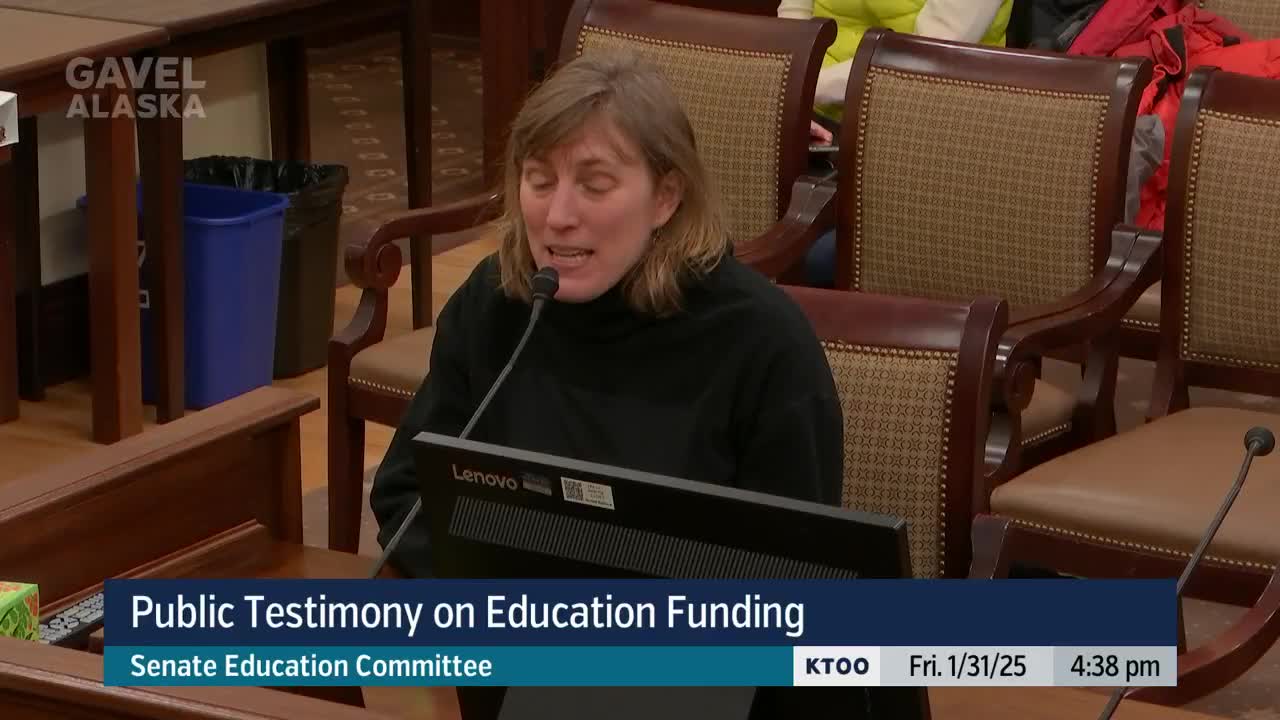Anchorage parents urge lawmakers to fully fund education amid growing funding crisis
January 31, 2025 | Education, Standing Committees, Senate, Committees, Legislative, Alaska
This article was created by AI summarizing key points discussed. AI makes mistakes, so for full details and context, please refer to the video of the full meeting. Please report any errors so we can fix them. Report an error »

Alaska's education system faces a critical funding crisis, as highlighted during the Senate Education Committee meeting on January 31, 2025. Parents, educators, and community members voiced urgent calls for increased funding to the Base Student Allocation (BSA) to ensure equitable educational opportunities for all students across the state.
Testimonies from Anchorage and Fairbanks underscored the dire consequences of underfunding. Tracy Fishbach, a parent from Anchorage, expressed concern over larger class sizes and fewer staff, which have hindered her children's ability to access vital educational resources. She emphasized the need for smaller class sizes and better support for teachers to maintain the quality of education that has historically attracted families to Alaska.
In Fairbanks, Tamara Cruz Rosales reported that the district has closed several schools and is facing a $6 million deficit, despite significant cuts to programs like music and art, which are essential for student success. She urged legislators to increase the BSA and inflation-proof it to combat the rising costs of education.
Other parents echoed similar sentiments, stressing that without adequate funding, programs that enhance student learning, such as gifted and language immersion programs, are at risk. Megan Peltier, also from Anchorage, highlighted the importance of these programs for her children and the broader implications for educational equity.
The meeting revealed a consensus among stakeholders that the current funding model is unsustainable. Many speakers warned that without immediate action, Alaska risks losing families and educators, further exacerbating the educational crisis. The urgency of the situation was palpable, with calls for lawmakers to prioritize education funding as a nonpartisan issue critical to the state's future.
As the committee continues to deliberate, the testimonies serve as a stark reminder of the pressing need for a comprehensive funding solution to ensure that all Alaskan students receive the quality education they deserve. The next steps will be crucial in determining the future of education in Alaska, as community members await a commitment from their legislators to address these challenges head-on.
Testimonies from Anchorage and Fairbanks underscored the dire consequences of underfunding. Tracy Fishbach, a parent from Anchorage, expressed concern over larger class sizes and fewer staff, which have hindered her children's ability to access vital educational resources. She emphasized the need for smaller class sizes and better support for teachers to maintain the quality of education that has historically attracted families to Alaska.
In Fairbanks, Tamara Cruz Rosales reported that the district has closed several schools and is facing a $6 million deficit, despite significant cuts to programs like music and art, which are essential for student success. She urged legislators to increase the BSA and inflation-proof it to combat the rising costs of education.
Other parents echoed similar sentiments, stressing that without adequate funding, programs that enhance student learning, such as gifted and language immersion programs, are at risk. Megan Peltier, also from Anchorage, highlighted the importance of these programs for her children and the broader implications for educational equity.
The meeting revealed a consensus among stakeholders that the current funding model is unsustainable. Many speakers warned that without immediate action, Alaska risks losing families and educators, further exacerbating the educational crisis. The urgency of the situation was palpable, with calls for lawmakers to prioritize education funding as a nonpartisan issue critical to the state's future.
As the committee continues to deliberate, the testimonies serve as a stark reminder of the pressing need for a comprehensive funding solution to ensure that all Alaskan students receive the quality education they deserve. The next steps will be crucial in determining the future of education in Alaska, as community members await a commitment from their legislators to address these challenges head-on.
View full meeting
This article is based on a recent meeting—watch the full video and explore the complete transcript for deeper insights into the discussion.
View full meeting
